Pros
Cons
Performance
As stated above, the ZR500 comes equipped with a 1/6" CCD and 680K gross pixels. In 4:3, it yields 340K effective pixels, in 16:9 with the electronic image stabilization (EIS) engaged, it yields 400K effective pixels; in 16:9 with the EIS disengaged, 450K effective pixels. All ZR models, like last year, feature the DigicDV processor. Last year’s ZR100 had a video performance that was somewhat dull and didn’t display the more brilliant tones found on higher-end models. The same imaging system is found in all 2006 ZRs, so don’t expect a jump in performance. Add-ons and extra features are what make up most of the price differences.
Low Light Performance
Last year, the ZR line did well with low light tests, considering the price range and relatively small 1/6" CCDs, producing results that made these camcorders a viable option for the budget consumer. The ZR100, the predecessor to the ZR500, produced colors at 15 lux that were acceptable and somewhat impressive considering the price range, though they were fairly noisy. Since the ZR100 and ZR500 share the same imager, we can probably expect similar low light results.
Format
**
Compression**
Video on the ZR500 is captured at the standard DV compression rate of 25 Mbps per second. There is no still capture capacity on this camcorder.
Media
The Canon ZR500 records video directly onto standard MiniDV tape.
Editing
The ZR500 uses MiniDV tape, which can be captured and imported into every major editing program. Though the transfer time to a computer is much longer than DVD and solid state camcorders, those formats can experience sound drop-off when imported into certain programs, and are often limited to editing with the manufacturer’s proprietary software bundles.
Tour
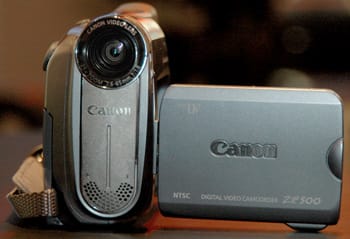
**The Front **
The front of the Canon ZR500 has a very minimalist design, an aesthetic which isn’t surprising considering the camcorder’s slender frame, and the fact that it’s the cheapest camcorder in their entire camcorder line. At the top of the camera body is the 25x optical / 800x digital zoom lens. It has a focal length of 2.6 – 65mm, which in a 35mm equivalent gives 49.8 – 1245mm in 4:3, 43.8 – 1095mm in 16:9 with EIS, and 41.0 – 1025,, in 16:9 with the EIS off. Below this lens, at the bottom of the camcorder, is the in-camera stereo microphone.
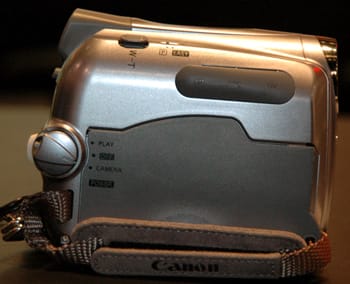
**The Right Side **
This tape compartment is bottom-loading, and faces the right side. Long-time MiniDV users will know this is a less than ideal design. Bottom-loading compartments force users to remove camcorders from tripods and disturb shots when switching tapes, while top-loading models allow for quick tape changes without hassle. Running across the lower portion, just along the hatch door, is an adjustable gray hand strap for more secure shooting. The mode dial is on the right rear of the body. Above the MiniDV compartment is a rubber port cover which conceals an A/V port, mic-in port, and FireWire port. There is no SD memory card slot or USB port on the ZR500. You’ll have to step up to the ZR600 for that luxury.
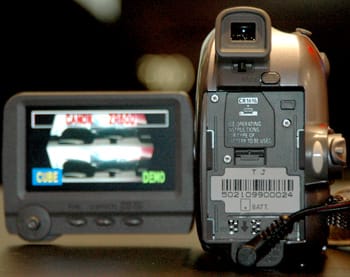
**The Back **
The back of the Canon ZR500 is a slender 1.9 inches and is predominately consumed by the camcorder’s battery. Above the battery users will find the 0.3-inch 123K pixel viewfinder, which unfortunately neither pivots nor extends. Taken in conjunction with control panel having been relocated to the LCD panel, Canon doesn’t expect you to get too much use out of the viewfinder. Lastly, the DC in port is located at the bottom of the camcorder beneath the battery.
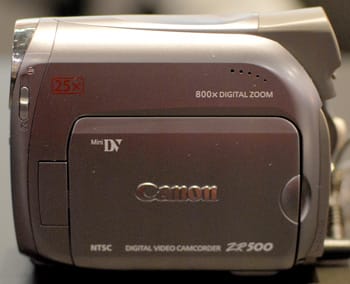
**The Left Side **
The ZR500 features a 2.7-inch, 112K pixel widescreen LCD that is opened via a tab located on the back edge of the monitor. Last year, controls were administered between buttons in the LCD cavity and a jog dial on the left side of the body. This year, the controls have been relocated to the bottom of the LCD panel. Controls include a four-way control pad, Function menu button, Digital Effects button, and Widescreen / Data Code button. This placement still means that users won’t be able to navigate and enter manual controls without opening the LCD screen, and also won’t be able to use the viewfinder for focus adjustment – an unfortunate loss, but still a better design than last year’s models. A lot people seem to complain about jog dials, and Canon must have heard. But if conserving batteries or shooting with the viewfinder are high priorities, this camcorder will probably disappoint.
**
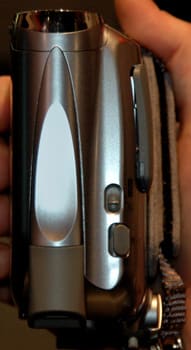
The Top**
The slender frame of the is very sparse indeed. There are only two controls found here: a raised zoom toggle, which is both well-placed and easily controllable, and a sliding switch to select between P (manual) and Easy modes.
Auto / Manual Controls
Picture & Manual Control
*Automatic Control *
Canon, like Sony, knows the allure of the Easy Mode to most consumers. They advertise the setting prominently on the upper-right side of the camcorder. In Easy Mode, users needn’t concern themselves with adjustments pertaining to focus, exposure, aperture, shutter speed, white balance, or other settings. Automatic controls on Canons are usually good. In fact, we recommend leaving a low-budget camcorder like this in auto mode most of the time. The manual controls are too limited.
There are some pre-set auto exposure modes to choose from on the ZR500, which can be selected from Recording Programs in the Function menu. They include: Portrait, Sports, Night, Snow, Beach, Sunset, Spotlight, and Fireworks.
*Overall Manual Control *
Bottom line: This is a the cheapest camcorder of the year from a manufacturer who withholds independent aperture and shutter speed control on all but their pro-cams. Don’t expect much, and you might be surprised with what you get. In terms of overall manual control, the ZR500 does manage to provide users with control options in Program Mode, although the control layout is less than stellar (a rear-mounted control is preferable). The ZR500 lets users manipulate zoom, exposure, focus, shutter speed, and white balance. There is no control over manual gain. There are also a handful of preset shooting modes (described above) which allow users who are less comfortable with manual controls to make some simple image adjustments.
Zoom
The ZR500, like all of the new ZRs, features 25x optical zoom. This model and the next up have 800x digital zoom. A step up to the ZR700 yields a 1000x digital zoom. Last year’s ZR100 only had a 20x optical zoom. Also, all the ZRs now feature a zoom control, accessed through the menu. This sets the zoom at a fixed speed regardless of how much pressure you put on the toggle. Speed 1 crawls quite slowly. Speed 2 is moderate. Speed 3 is quite fast. The Variable setting turns the speed limit control off.
*Focus *
You will find a manual focus setting on the ZR500, but we can’t recommend its use accept in extreme circumstances. The ZR500’s auto focus tends to struggle when forced to function in lower light conditions. Instead of settling on the correct subject, the camcorder will "breathe," a term which refers to its fluctuating in-and-out of focus and the inability for the camera to settle on one subject and distance. Although the inclusion of a manual focus is welcome, the focus is digitally controlled through four-way controller. There is no numerical value attached to focal adjustments, and you have only your eyes and the LCD to gauge precision. Because of the control placement on the LCD panel, you can’t even use the viewfinder to make adjustments. Our advice: leave it in auto and stay in well-lit places.

*Exposure (Aperture) *
There is manual control for exposure compensation setting on the Canon ZR500. It allows users to select among +/-11 EV steps, giving you a total of +/-2.75 EV. This is a rather limited approach to exposure control, whereas independent aperture and shutter speed controls might be applied. In fact, the ZR500’s manual only mentions exposure adjustment as a means of correcting for backlighting problems.
*

Shutter Speed*
This camcorder, like all those present in the ZR line, provide users with manual control over shutter speed. The manual shutter speed options on the ZR500 are: 1/60, 1/100, 1/250, 1/500, 1/1000, and 1/2000 of a second. There is also a Slow Shutter speed setting for night shooting, accessed through the menu. It is fixed at 1/30 of a second.
White Balance
Manual white balance settings for the Canon ZR500 include Auto, Daylight, Tungsten, and Set (manual) . This isn’t exactly an extensive list and situations like indoor lighting or shade will call for either the Auto or Manual settings. It’s too bad; white balance is one simple adjustment that can make a dramatic difference in the quality of a shot, and users who rely on presets will think less of this cam for its lack of options.
Gain
There is no manual gain setting on any camcorders in the Canon ZR series.
Still Features
Still Features
The Canon ZR500 does not have the ability to capture stills, even to MiniDV tape. The next model up, the ZR600, does feature an SD card capacity and shoots at a maximum resolution of 1024 x 768.
Handling and Use
****Handling****
The handling on the ZR500 seems to have improved over last year. The body has slimmed down by 16% in size and 12% in weight. The jog dial, which received a lot of complaints, has been replaced with a four-way navigation pad – a type of control you’ll also find on most JVCs this year. But you cant please everyone. Some people have already complained about the placement of the navigation pad. Certainly, it raises some issues. If the navigation controls are located on the LCD, Canon has essentially negated the viewfinder as anything but a secondary viewing device. You can’t use it to make adjustments, because the viewfinder shuts off when the LCD panel is opened. Also, we have to question whether the ZRs shrunk in "the right way." Panasonic claims that shorter, fatter camcorders actually lay better in the hand. Conversely, Canon has squeezed their camcorders thin. Which is better? It’s a matter of personal preference. The Canons certainly win in aesthetics, but the Panasonics sure felt right. We need a little bit more time with this one – and we need camcorders that are not tethered to the manufacturer’s booth.
****LCD/Viewfinder**
** The LCD screen on the Canon ZR500 provides a large viewing surface of 2.7 inches, which is great when capturing in 16:9 aspect ratio. When shooting in standard 4:3, the image will appear pillar-boxed. The 112K pixel count is a little low. There is no increase in LCD resolution through the rest of the ZR series. Only a step up to the Elura 100 will boost the pixel count to 123K. As stated above, the LCD panel is also where the control panel is located.
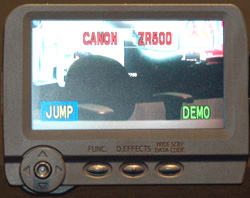
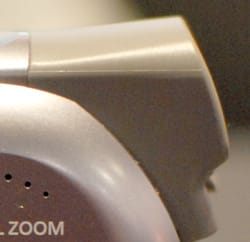
The camcorder also comes with an Electronic Color Viewfinder that has 123,000 pixels packed onto a 0.3-inch screen. But it has its own limitations and restrictions; it is unfortunately unable to extend or rotate away from the camera body. This means users will need to press a face into the battery pack to really get close enough for an accurate image reading. Also, because the control panel is located on the LCD panel, changes to image quality, such a focus, cannot be gauged with the viewfinder.
Audio / Playback / Connectivity
****Audio****
Strange as it may seem, the ZR500 is only model in the ZR series to include a microphone input. Evidently, the decision to equip less expensive camcorders with more audio options was in direct reaction to the demands of educators who need inexpensive camcorders as well as expanded audio options. While certainly not wishing to disrespect this evidently key sector of Canon’s market, I think that camcorder manufacturers would find that users who are willing to pay more are also after more features, not less.
Not only do they include the option for an external mic, but the jack is well-placed on the right side of the body, reducing the possibility that a dangling wire will not get in the way of a shot. Unfortunately, there is no accessory shoe on top in which to place a mic.
A built-in stereo microphone is located in the lower front of the body, under the lens. Audio quality can be set at 12bit or 16bit. A Wind Screen feature is available, which cuts the low end of the audio signal to reduce wind noise. There is no manual control of audio levels.
**

**
****VCR Mode**
** The VCR mode for the ZR500 is entered when the user switches the mode is set on "Play." Once the camcorder is in playback mode users can navigate the MiniDV tape through the use of the four-way control pad. As we are now awash in a market of DVD and solid state camcorders, playback on a MiniDV can seem slow and tedious – all that tape to wind back and forth. It’s like the Stone Age! Seriously though, playback on the ZR500 is straightforward and perfectly serviceable. The big hassle is the bottom loading tape mechanism. If the camcorder is in a tripod, changing tapes can become time-consuming.
****Ports**
** There are several ports available on the ZR500, most found on the right side of the ZR500’s body, underneath a rubber port cover: DV (FireWire), composite A/V-out, and mic-in ports which are positioned so as to not be blocked or compromised by either the tape compartment or the right-hand grip, a common mistake on camcorders with ports on this side. On the back of the ZR500, below the battery and right near the bottom, users will find a DC-in port. This camcorder does not support analog-to-digital conversion or pass through. With the cut in price from the ZR600 to the ZR500, you lose the USB port and the SD card slot; however, you do gain the mic input.
**
**
Other Features
****Other Features***
**** Electronic Image Stabilization* - The Canon ZR500 comes with Electronic Image Stabilization, and while this will help slightly during jittery shooting and handling,
Digital Effects - The ZR500 includes effects for Black and White, Sepia, Art, Mosaic, Ball, Cube, Wave, Color Mask, and Mirror. There are Fade effect for: Fade to Black. Wipe, Corner Wipe, Jump, Flip, Puzzle, Zigzag, Beam, and Tide.
**
**
Comparisons / Conclusion
****Conclusion**
** The ZR500 (MSRP $299) features several controls which help to separate itself from the older ZR100. The largest immediate change is in the physical design of the camcorder itself. This model features a slimmer, more slender silhouette which permits greater portability and handling. There is also a slight increase in LCD size to 2.7 inches, and an increase in optical zoom to 25x. Although this model doesn’t have the USB port and SD card slot found on the ZR600 and ZR700, it does have a mic-in jack, a great feature that doesn’t appear on either. This inclusion may make this camcorder an edge over other ZR cams, depending on your priorities. What else do you miss out on by not stepping up? The ZR600 ($349) offers an improved 9-Point AiAF auto focus, a remote control, and some software. The ZR700 ($399) has an increased 1000x digital zoom (a red herring of a feature), a vide light, and analog to digital pass through. This last feature is perhaps the only worthwhile one, and it will cost you $100 extra dollars. It will be interesting to test this new camcorder against the results garnered with the ZR100 and ZR200 reviewed during 2005. With the visual emphasis on a sleeker, more slender style-conscious design, it will be interesting to see if Canon too has submitted to the trend of offering style over substance. Only full testing will tell, so check back for our in-depth review.
Meet the tester

James Murray
Editor
James Murray is a valued contributor to the Reviewed.com family of sites.
Checking our work.
Our team is here to help you buy the best stuff and love what you own. Our writers, editors, and experts obsess over the products we cover to make sure you're confident and satisfied. Have a different opinion about something we recommend? Email us and we'll compare notes.
Shoot us an email